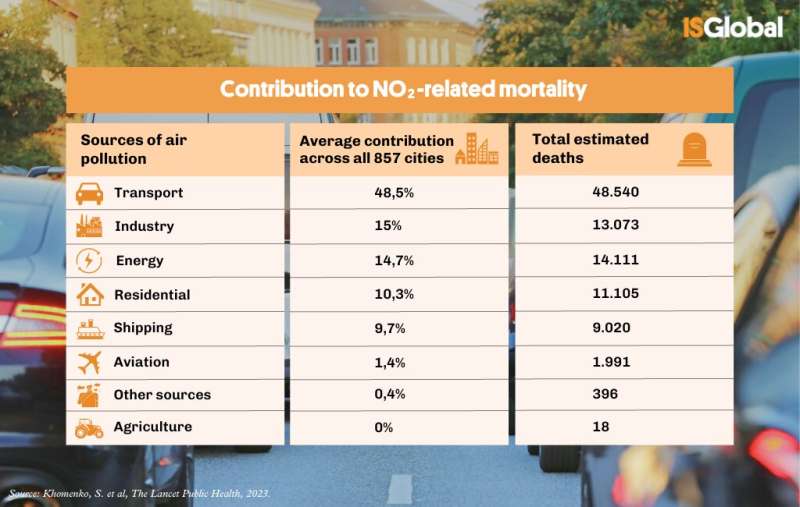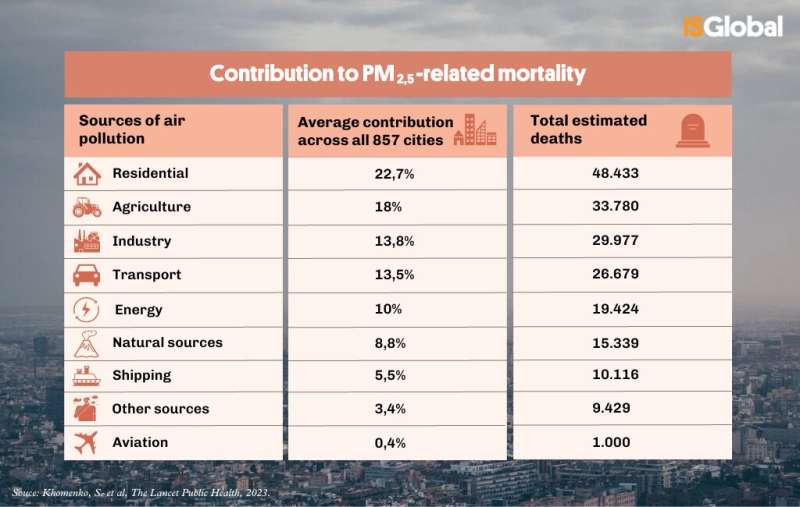This article has been reviewed according to Science X's editorial process and policies. Editors have highlighted the following attributes while ensuring the content's credibility:
fact-checked
peer-reviewed publication
trusted source
proofread
Transport, domestic activities, agriculture are main contributors to air pollution-related mortality in Europe: Study

Air pollution is the largest environmental cause of death. Now, a study led by the Barcelona Institute for Global Health (ISGlobal), a center supported by the "la Caixa" Foundation, has estimated which sources contribute most to the mortality associated with two air pollutants—PM2.5 and NO2—in 857 European cities.
The results of this research, which have been published in The Lancet Public Health, show great variability between the different cities studied, suggesting that, given that each one has its own particularities and its own sources of air pollution, strategies to improve air quality should be adapted to each local context.
Contributors to PM2.5 mortality
Pooling the data for the 857 cities, the figures show that the largest contributor to PM2.5 mortality is emissions from residential sources, with an average contribution across all cities of 22.7%. In second place is the agricultural sector, which accounts on average for 18% of PM2.5 mortality, followed by industry (13.8%), transport (13.5%), the energy sector (10%), natural sources (8.8%) and shipping (5.5%).
"If we look at NO2 and PM2.5 combined, traffic remains the largest contributor to both poor air quality and associated mortality. However, if we look exclusively at the PM2.5-related mortality, we see a significant contribution from the residential sector and agriculture," notes Sasha Khomenko, ISGlobal researcher and first author of the study.
"Although we have not broken down the specific sources of emissions for each sector in our study, we do know from the scientific literature that most of the particulate matter generated at the household level is mainly due to biomass and coal burning for heating and, to a lesser extent, fossil fuel-based systems for heat and hot water generation and gas cookers," Khomenko explains. "We know that rising fossil fuel prices and climate change mitigation policies have led to an increase in biofuel use. However, the fact that they are products of natural origin does not mean that they are not harmful to health," she adds.
"As far as agriculture is concerned, intensive livestock farming is known to be a major source of particulate matter, which is generated mainly from ammonia in animal slurry and also through the use of certain fertilizers. It is a source of pollution that spreads from its place of origin and moves to nearby cities," she says.

PM2.5 particles are the air pollutant with the greatest negative impact on mortality in European cities. The team stresses that more research is needed to determine which components of PM2.5 particles are most harmful to health, so that more precise mitigation measures can be designed.
NO2 is a gas that is generated in combustion processes, mainly from motor vehicles, but also in industrial or power generation facilities.
"Bolder measures are required to drastically reduce pollution and deaths associated with traffic, which remains the main source of emissions. And, at the same time, implement policies to mitigate the other sources of both NO2 and PM2.5 emissions, such as regulating emissions from industry and shipping, and limiting biomass burning in households and emissions from agriculture and livestock," says Mark Nieuwenhuijsen, director of ISGlobal's Urban Planning, Environment and Health Initiative.
"To reduce air pollution we need multisectoral holistic action and solutions, for example with task forces across the current silos (e.g., urban planning, transport engineering, housing, environment, health, education, agriculture, business) at city, national and EU levels," Nieuwenhuijsen adds.
Methodology
The study focused on 857 European cities that appear in the Urban Audit 2018 dataset. Baseline NO2 and PM2.5 emissions data, relating to 2015, were obtained from the regional Copernicus Atmosphere Monitoring Service inventory and classified into 12 sectors using a standard nomenclature system (GNFR). In addition, population and mortality figures for the 857 cities were obtained from public databases, also for the year 2015.
To estimate the contribution of each emission source to the concentration of pollutants in the atmosphere, the researchers used the Screening for High Emission Reduction Potentials for Air quality (SHERPA) tool developed by the European Commission's Joint Research Center (JRC). This tool applies the principles of chemical transport models in a simplified way. These models take into account factors such as meteorology or chemical transformations to simulate the concentration of pollutants in the atmosphere.
The research team divided the surface area of the European cities studied into 36 km2 grids. Using SHERPA, they estimated the changes in atmospheric concentrations of PM2.5 and NO2 that would occur if emissions were reduced in each of the grids on the map and calculated the relative contribution of each of the pollution sources.
Finally, a comparative risk assessment was carried out to estimate the mortality that could be prevented under different scenarios of reduced pollutant concentrations associated with each of the emission sources.
It should be noted that, due to the spatial resolution of the study, estimates made for smaller cities may be less precise than those for larger cities.
More information: Spatial and sector-specific contributions of emissions to ambient air pollution and mortality in European cities: a health impact assessment, The Lancet Public Health (2023). DOI: 10.1016/S2468-2667(23)00106-8




















